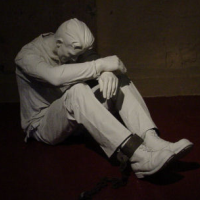One in Four California Prisoners Join Hunger Strike

If 29,000 California prisoners are going to stay on a hunger strike, begun in earnest this week, until their demands are met—improved prison conditions, in general, and solitary confinement, in particular—the state will probably have a noticeably thinner prison population.
Jules Lobel, the president of the Center for Constitutional Rights and the lead lawyer in a federal lawsuit over solitary confinement, told the New York Times the inmates won’t settle for the promises of reform they received in 2011 when 6,000 prisoners participated in a hunger strike that stretched over several weeks. “This could become a very serious situation over time, because it seems we have a substantial group of people who are prepared to see it to the end if they don’t get real change,” he said.
Lobel did not elaborate in the Times what he meant by “the end.” But real change may be easier to define, because the depravations of California’s prisons are well known. The state is currently fighting federal court orders to quickly reduce its 130,000-prisoner population by 10,000 inmates because of overcrowding. But solitary confinement practices, which have galvanized the hunger strike, have been a source of conflict for a long time, too.
Around 5,000 prisoners are in solitary confinement, otherwise known as security housing units (SHU) at any one time. A 2012 report from Amnesty International said, “No other US state is believed to have held so many prisoners for such long periods in indefinite isolation.” The organization said it was a “breach [of] international standards on humane treatment . . . that amounts to cruel, inhuman or degrading treatment, in violation of international law.”
As of 2011, more than 500 prisoners serving indeterminate terms in isolation had spent at least 10 years doing so. More than 200 had been isolated for 15 years and 78 for 20 years. Many of those in isolation have been identified by corrections authorities as prison gang members.
At least eight different lists of demands have been received by prison officials, according to the Los Angeles Times. One of them was a detailed letter from 10 prisoners at High Desert State Prison in Susanville. They listed five core demands, 40 supplemental demands and 30 demands specifically about solitary confinement. They include better library services, better food, more variety of TV channels, cleaner facilities and weekly visits by officials to solitary talk with prisoners about their complaints.
The strike coincides with the beginning of Ramadan, the Muslim month of fasting, which will make it difficult for prison officials to tell exactly how many inmates are actually on a hunger strike.
Inmate Alfred Sandoval, who has been in solitary confinement at Pelican Bay State Prison since 1987, wrote in a petition signed by 400 prisoners and sent to the United Nations last year that “SHU is a soul-sucking, mind-bending torture that murders all humanity in any human being. Some die quicker than others . . . but we all die inside.” Sandoval was convicted of four murders and one attempted murder.
–Ken Broder
To Learn More:
Hunger Strike by California Inmates, Already Large, Is Expected to Be Long (by Jennifer Medina, New York Times)
30K Calif. Prisoners Hunger Strike Could Last for Weeks (by Elizabeth Flock, U.S. News & World Report)
Tens of Thousands of California Prisoners Launch Mass Hunger Strike (by Victoria Law, The Nation)
29,000 California Prison Inmates Refuse Meals in 2nd Day of Protest (by Paige St. John, Los Angeles Times)
Federal Judges Order Immediate Release of 10,000 Inmates from Overcrowded California Prisons (by Ken Broder, AllGov California)
Amnesty International Condemns California Prisons’ Use of Indefinite Isolation (by Ken Broder, AllGov California)
- Top Stories
- Controversies
- Where is the Money Going?
- California and the Nation
- Appointments and Resignations
- Unusual News
- Latest News
- California Forbids U.S. Immigration Agents from Pretending to be Police
- California Lawmakers Urged to Strip “Self-Dealing” Tax Board of Its Duties
- Big Oil’s Grip on California
- Santa Cruz Police See Homeland Security Betrayal in Use of Gang Roundup as Cover for Immigration Raid
- Oil Companies Face Deadline to Stop Polluting California Groundwater





